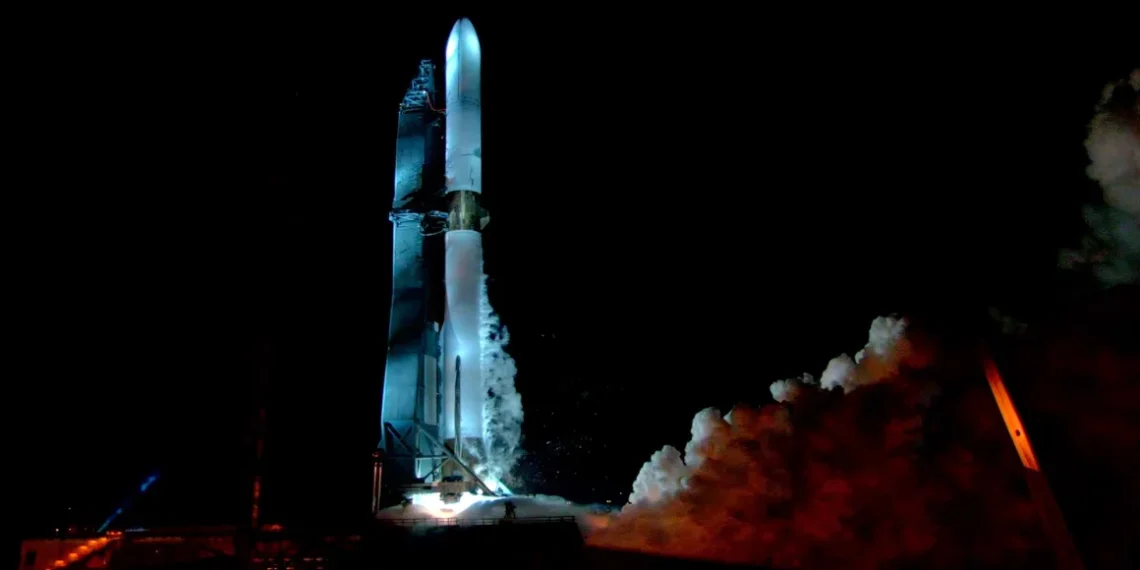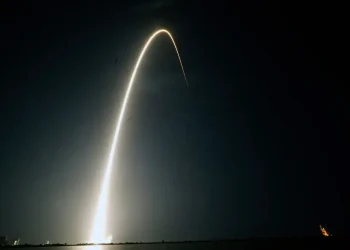Blue Origin’s New Glenn Rocket Poised for Maiden Launch at Cape Canaveral
Blue Origin, Jeff Bezos’ space company, is preparing for the maiden flight of its New Glenn rocket, set to launch from a Florida launchpad that has remained dormant for nearly two decades. Standing at an impressive 320 feet (98 meters), this uncrewed rocket represents a significant step for Blue Origin, marking its first attempt to send a rocket into orbit—a crucial move if the company hopes to challenge SpaceX’s long-standing dominance in the space industry.
A New Era of Space Exploration
Scheduled to lift off from Cape Canaveral Space Force Station as early as next week, New Glenn’s first flight is a highly anticipated event. This massive rocket consists of a first-stage booster for initial thrust, with an upper stage housing a cargo bay protected by a nose cone. For this inaugural mission, the cargo bay will contain experimental technology designed to test the rocket’s capabilities.
Emulating SpaceX’s success with reusing rocket boosters, Blue Origin will also attempt to land New Glenn’s first-stage booster on a seafaring platform, named Jacklyn in honor of Bezos’ mother, minutes after liftoff.
The company aims to follow in SpaceX’s footsteps by recovering, refurbishing, and reusing rocket boosters to reduce costs. However, while Blue Origin hopes for success, a flawless flight is not guaranteed, as is typical for inaugural missions.
A Key Player for Blue Origin’s Vision
New Glenn’s successful debut is vital to Blue Origin’s ambitious future plans. The rocket could one day power national security launches, deploy Amazon’s Kuiper internet satellites, and assist in building a space station with commercial partners. Named after the legendary NASA astronaut John Glenn, this heavy-lift vehicle is designed to rival SpaceX’s Falcon 9 and even carry up to 45 metric tons (99,200 pounds) into orbit.
Delays and Slow Development
Blue Origin announced the development of New Glenn in 2016, initially aiming for its first launch by 2020. However, as is common in the aerospace industry, delays have pushed the launch back significantly. Despite this, Blue Origin has maintained its cautious, methodical approach, with Bezos famously stating, “Slow is smooth, and smooth is fast.” This philosophy, embodied by the company’s mascot, a tortoise, contrasts with SpaceX’s speedier, trial-and-error approach.
SpaceX’s Dominance and Blue Origin’s Strategy
While Blue Origin has taken a more deliberate path, SpaceX has been the dominant force in launching rockets to orbit. SpaceX’s Falcon 9 rocket, for instance, has launched hundreds of successful missions to space. Despite the occasional test failure, SpaceX’s reliability with operational missions has solidified its place at the forefront of the industry.
Blue Origin, in contrast, is better known for its space tourism efforts via its New Shepard rocket—a smaller, suborbital vehicle. While New Shepard has conducted more than 20 flights, it hasn’t been used for orbital missions. The company’s debut into the world of orbital launches with New Glenn could mark a turning point in its efforts to compete with SpaceX.
A Strong Start: New Glenn’s First Mission
For its first flight, Blue Origin had initially planned to launch Mars-bound satellites for NASA. However, delays have shifted that mission to later in the year. Instead, Blue Origin will test a technology demonstrator that will validate essential communications and tracking systems needed for future missions. This technology, part of Blue Origin’s Blue Ring spacecraft project, is aimed at supporting in-space ridesharing capabilities for satellite deployments.
New Glenn’s Position in the Market
New Glenn offers significant power, sitting between SpaceX’s Falcon 9 and Falcon Heavy rockets in terms of lifting capacity. The rocket can carry up to 45 metric tons (99,200 pounds) to orbit—double the payload of Falcon 9. Despite this, New Glenn’s launch price is reportedly comparable to Falcon 9 at around $60 million to $70 million per launch. However, sustaining competitive pricing may be a challenge for Blue Origin in the long run.
One of New Glenn’s standout features is its large payload fairing—a 23-foot (7-meter) wide nose cone, nearly 6 feet (2 meters) larger than SpaceX’s Falcon 9. This enormous size allows Blue Origin to accommodate larger payloads, aligning with Bezos’ vision of removing heavy industries from Earth and building a sustainable future in space.
Competing with SpaceX’s Starship
Despite New Glenn’s power, Blue Origin faces formidable competition from SpaceX’s upcoming Starship. At nearly 400 feet (121 meters) tall, Starship is set to become the largest and most powerful rocket ever constructed, with the potential to carry up to 300 tons to orbit. SpaceX’s aggressive development of Starship may eventually lower the cost per kilogram to space, presenting a major challenge for Blue Origin.
The Reusability Factor
Similar to SpaceX, Blue Origin aims to revolutionize spaceflight by reusing its rocket boosters. Reusability has been integral to reducing the cost of launches, and Blue Origin has embraced this goal since its inception. While Blue Origin’s efforts have taken longer to materialize, the company’s commitment to reusable rockets has been steadfast.
If successful, New Glenn’s booster recovery would be a remarkable achievement. After expending most of its fuel, the first-stage booster will need to separate cleanly, maneuver with pinpoint precision, and ignite its engines to land safely on the Jacklyn platform.
Looking Ahead
As Blue Origin looks toward its first orbital launch, the company is positioning itself as a long-term player in the aerospace industry. While its path has been slower than SpaceX’s, its dedication to innovation and reusability could make it a serious competitor in the years to come. The success of New Glenn will be crucial not only for Blue Origin’s future but also for the broader space industry as it enters a new era of competition, exploration, and commercialization.
This article was rewritten by JournosNews.com based on verified reporting from trusted sources. The content has been independently reviewed, fact-checked, and edited for accuracy, neutrality, tone, and global readability in accordance with Google News and AdSense standards.
All opinions, quotes, or statements from contributors, experts, or sourced organizations do not necessarily reflect the views of JournosNews.com. JournosNews.com maintains full editorial independence from any external funders, sponsors, or organizations.
Stay informed with JournosNews.com — your trusted source for verified global reporting and in-depth analysis. Follow us on Google News, BlueSky, and X for real-time updates.














